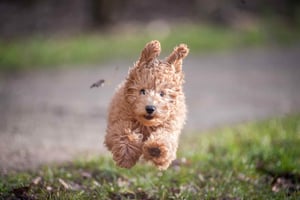Housebreaking your puppy is one of the most important aspects of early puppy training. Teaching...
Effective Ways to Curb Puppy Biting
Teaching a puppy not to bite is an important part of puppy training. It can be a challenging task, but with patience and consistency, you can get your puppy to stop biting. In this article, we'll discuss the different methods you can use to get your puppy to stop biting and the importance of positive reinforcement.
Why Do Puppies Bite?
Puppies bite for a variety of reasons. A puppy may be teething, exploring, or playing. It’s important to understand why your puppy is biting so you can address the issue correctly. If your puppy is teething, you can provide them with toys that are specifically designed for teething puppies. If your puppy is exploring or playing, redirect their attention to a toy or chew bone.
It’s also important to remember that puppies can bite out of fear. If your puppy is fearful of something, it’s important to take steps to help them feel more comfortable. Speak to your veterinarian or a professional dog trainer for advice on how to help your puppy feel more secure.
Using Positive Reinforcement
Positive reinforcement is one of the most effective methods for teaching your puppy not to bite. When your puppy is not biting, reward them with treats or verbal praise. This will help them learn that not biting is the desired behavior. When your puppy does bite, use a firm “No” and immediately redirect their attention to a toy or chew bone.
It’s important to be consistent with this method. If your puppy bites, you should always say “No” and redirect their attention. If you don’t respond consistently, your puppy may become confused and continue to bite.
Using Distraction Techniques
Distraction techniques can also be used to teach your puppy not to bite. When your puppy starts to bite, distract them with a toy or chew bone. You can also use a loud noise, such as a whistle or clap, to startle them and get their attention. The goal is to get them to focus on something else instead of biting.
It’s important to remember that distraction techniques should only be used in moderation. If you use them too often, your puppy may become desensitized to them and they won’t be as effective.
Using Deterrents
Deterrents can also be used to get your puppy to stop biting. A deterrent is something that your puppy finds unpleasant and will avoid. Common deterrents include bitter apple spray, citronella spray, or a squirt bottle filled with water.
When your puppy starts to bite, spray them with the deterrent. The goal is to startle them and get them to stop biting. It’s important to only use deterrents in moderation. If you use them too often, your puppy may become desensitized to them and they won’t be as effective.
Using Timeouts
Timeouts can also be used to get your puppy to stop biting. When your puppy starts to bite, immediately remove them from the situation and put them in a timeout. The goal is to give them time to calm down and refocus. It’s important to remember that timeouts should be short and the goal is not to punish your puppy.
If your puppy is biting out of fear, it’s important to take steps to help them feel more comfortable. Speak to your veterinarian or a professional dog trainer for advice on how to help your puppy feel more secure.
Conclusion
Teaching a puppy not to bite is an important part of puppy training. It can be a challenging task, but with patience and consistency, you can get your puppy to stop biting. There are a variety of methods you can use, such as positive reinforcement, distraction techniques, deterrents, and timeouts. It’s important to be consistent and remember that the goal is not to punish your puppy.



